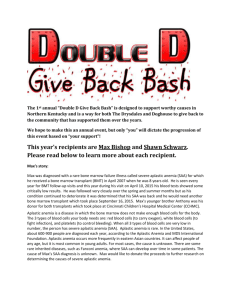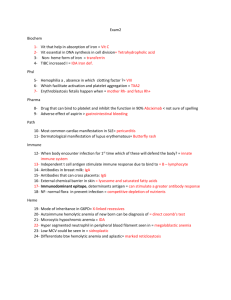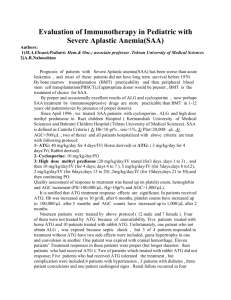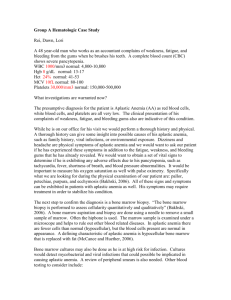Aplastic Anemia: Where Are We Today
advertisement
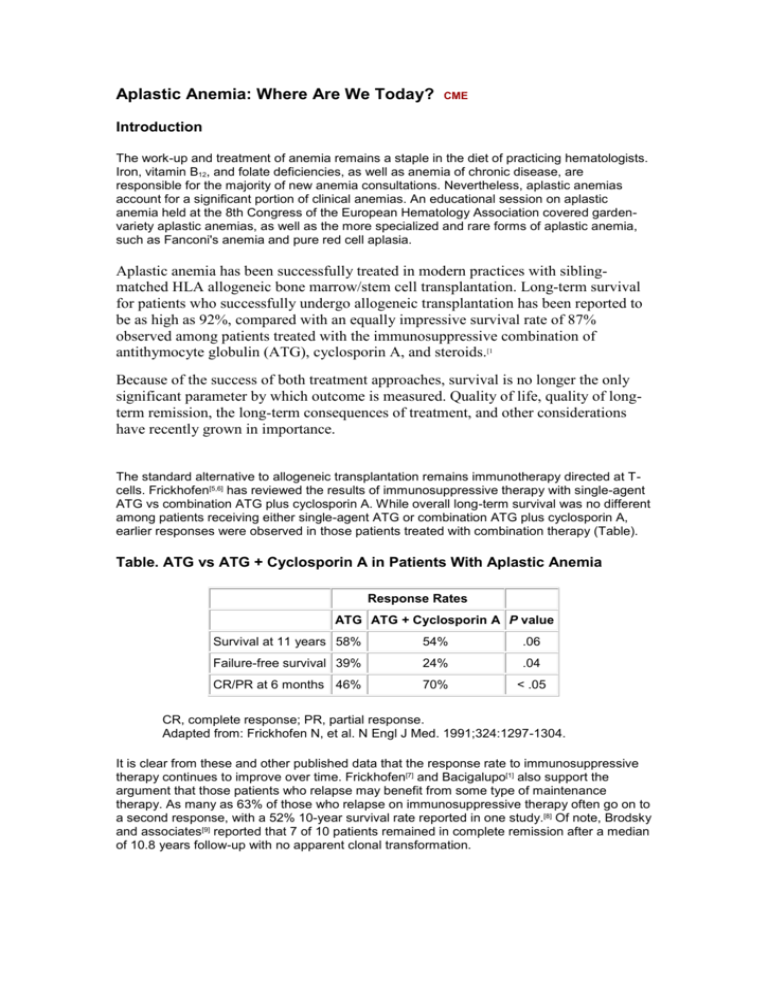
Aplastic Anemia: Where Are We Today? CME Introduction The work-up and treatment of anemia remains a staple in the diet of practicing hematologists. Iron, vitamin B12, and folate deficiencies, as well as anemia of chronic disease, are responsible for the majority of new anemia consultations. Nevertheless, aplastic anemias account for a significant portion of clinical anemias. An educational session on aplastic anemia held at the 8th Congress of the European Hematology Association covered gardenvariety aplastic anemias, as well as the more specialized and rare forms of aplastic anemia, such as Fanconi's anemia and pure red cell aplasia. Aplastic anemia has been successfully treated in modern practices with siblingmatched HLA allogeneic bone marrow/stem cell transplantation. Long-term survival for patients who successfully undergo allogeneic transplantation has been reported to be as high as 92%, compared with an equally impressive survival rate of 87% observed among patients treated with the immunosuppressive combination of antithymocyte globulin (ATG), cyclosporin A, and steroids.[1 Because of the success of both treatment approaches, survival is no longer the only significant parameter by which outcome is measured. Quality of life, quality of longterm remission, the long-term consequences of treatment, and other considerations have recently grown in importance. The standard alternative to allogeneic transplantation remains immunotherapy directed at Tcells. Frickhofen[5,6] has reviewed the results of immunosuppressive therapy with single-agent ATG vs combination ATG plus cyclosporin A. While overall long-term survival was no different among patients receiving either single-agent ATG or combination ATG plus cyclosporin A, earlier responses were observed in those patients treated with combination therapy (Table). Table. ATG vs ATG + Cyclosporin A in Patients With Aplastic Anemia Response Rates ATG ATG + Cyclosporin A P value Survival at 11 years 58% 54% .06 Failure-free survival 39% 24% .04 CR/PR at 6 months 46% 70% < .05 CR, complete response; PR, partial response. Adapted from: Frickhofen N, et al. N Engl J Med. 1991;324:1297-1304. It is clear from these and other published data that the response rate to immunosuppressive therapy continues to improve over time. Frickhofen[7] and Bacigalupo[1] also support the argument that those patients who relapse may benefit from some type of maintenance therapy. As many as 63% of those who relapse on immunosuppressive therapy often go on to a second response, with a 52% 10-year survival rate reported in one study.[8] Of note, Brodsky and associates[9] reported that 7 of 10 patients remained in complete remission after a median of 10.8 years follow-up with no apparent clonal transformation. As with allogeneic transplantation, age at the time of treatment is also predictive of outcome for those patients treated with immunosuppressive therapy. Five-year overall survival for adult patients under the age of 50 is 72%, vs 57% for patients ages 50-59, and 50% for patients 60 and older.[10] A trial comparing high-dose cyclophosphamide in lieu of ATG + cyclosporin A was stopped prematurely after only 31 of an anticipated 92 patients were enrolled, due to a significant increase in the number of toxic deaths among the high-dose cyclophosphamide cohort. [11] A recent update of this truncated trial continues to show no survival benefit to high-dose cyclophosphamide, essentially confirming the original conclusion that there is no need to employ high-dose cyclophosphamide when ATG + cyclosporin A is available and tolerable.[12] 12.Tisdale JF, Maciejewski JP, Nunez O, et al. Late complications following treatment for severe aplastic anemia with high-dose cyclophosphamide: follow-up of a randomized trial. Blood. 2002;100:4668-4670. Abstract Besides relapse, late complications associated with treatment for aplastic anemia include the development of myelodysplasia (MDS) or acute myeloid leukemia (AML) as well as lymphoma and solid tumors. Socie[13] reported 43 cases of MDS/AML, 1 lymphoma, and 12 solid tumors among 860 patients treated with immunosuppressive therapy, compared with 2 cases of MDS/AML, no cases of lymphoma, and 15 cases of solid tumors among 748 patients who underwent bone marrow transplantation. One report notes that the incidence of AML/MDS appears to be higher among those patients who received granulocyte colony-stimulating factor as supportive therapy.[14] Anticancer Drugs 2003 Mar;14(3):251-3 (ISSN: 0959-4973) Takabayashi M; Sakai R; Sakamoto H; Iemoto Y; Kanamori H; Inayama Y; Ishigatsubo Y Department of Hematology/Immunology, Fujisawa City Hospital, Fujisawa, Japan. t-maki@swim.seaple.icc.ne.jp. We report a patient who developed Merkel cell carcinoma (MCC) after treatment with antithymocyte globulin and cyclosporine for aplastic anemia. The clinical course was progressive and poor prognosis. Although MCC is relative rare in second cancers arising after immunosuppressive therapy, patients should be closely monitored for the development of this complication as well as other second malignancies. [Copyright 2003 Lippincott Williams & Wilkins]. Transplant Proc 2004 Mar;36(2 Suppl):22S-24S (ISSN: 0041-1345) Kostakis A 2nd Department of Propedeutic Surgery, Athens University, Medical School, Laiko General Hospital, Athens, Gree akostak@med.uoa.gr. Cyclosporine, a new antilymphocyte peptide, was tested in heterotopic heart transplantation between two differen strains of rats. Prolongation of rat heart allograft survival was observed in treated hosts as compared with untreated controls (P <.001). These pioneering studies in pedicle animal grafts proved that cyclosporine is an extremely pot immunosuppressive drug. Its ability to suppress allograft rejection episodes could be applied to other species of animals and to humans. Recenti Prog Med 2004 Feb;95(2):100 (ISSN: 0034-1193) Baratta L; Golluscio V; Delfino M Dipartimento di Medicina Clinica, Universita La Sapienza, Roma. We present a patient with isolated steroid resistant autoimmune haemolytic anaemia successfully treated with cyclosporin A for 7 months with no adverse side effects and free of disease after 2 years of therapy. We thus recommend to consider cyclosporin A as a first choice in steroid resistant patients with autoimmune haemolytic anaemia. More studies are necessary to assess the efficacy and safety of this treatment.
